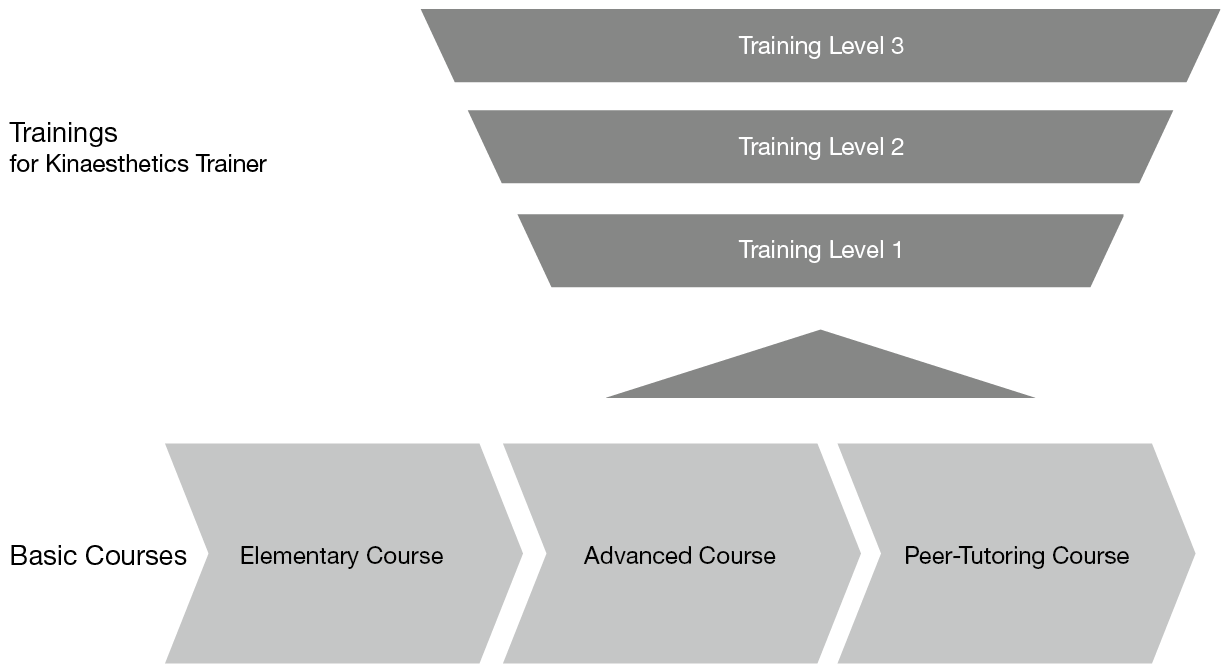The Kinaesthetics Course of Education
The Kinaesthetics Course of education consists of educational units that are self-contained and build on each other. The offer is aimed at people who, for personal or professional reasons, want to deal with their physical activity, health and learning on a personal, professional or organisational level. The personal area of Kinaesthetics concerns the examination of one's own movement competence, personality and health development. The professional area is aimed at people with an assignment to another person (parents, carers, educators, nurses, therapists). The organisational area deals with the importance of one's own movement competence in contact with a team or organization. The educational offerings vary depending on the application. A previous stage is usually the prerequisite for the next one.

The basic courses
The basic courses make it possible to take advantage of kinaesthetics knowledge and skills in various fields of application. These courses are mostly structured as "learning phases"
designed to be learned not only in the classroom. Practical learning between the course days is also planned and evaluated. Such a learning phase lasts 4 to 9 months. These
Learning phases are particularly sustainable when they work together with the executives
possibilities and objectives of the company.
Basic courses
In basic courses, the participants deal intensively with their own movement skills and get to know the Kinaesthetics concept system. This makes it possible to observe, better understand and actively change one's own movement in everyday activities from different perspectives.
Advanced courses
Based on the basic course, attendees in advanced courses can consolidate and deepen their personal movement skills and knowledge of the Kinaesthetics concept system. In addition, they learn to design learning processes in practice, to vary them and to identify and document learning progress.
Peer Tutoring courses
Peer tutors are the contact persons for Kinaesthetics in their work team.
In the Peer Tutoring courses, they develop the knowledge and competences to support colleagues in their learning process in practice who have attended or attend a basic or advanced course. They expand their kinaesthetics expertise and develop their methodological-didactic competencies based on the kinaesthetics learning model.
Publicly offered Kinaesthetics basic courses can be found on the website of the country organisations.
The trainer education
The trainer trainings in the personal and professional area take place extra-occupationally, usually take one year for each stage and each covers approximately 300 hours (including self-study). The
Kinaesthetics organisations of different countries organise and coordinate the trainings. Movement competence, health development and learning are the main topics.
In addition, the attendees acquire solid and modern methodological-didactic basics. The training courses are partly carried out in an assistance system, i.e. Trainees are required to provide regular assistance in courses taught by experienced trainers.
The Kinaesthetics trainer Level 1: The expert in your own professional field
Training as a Kinaesthetics trainer Level 1 is the transitional stage between the Kinaesthetics user and the Kinaesthetics trainer in levels 2 and 3. The attendees deal with under
cybernetic-kinaesthetic perspectives with specific questions of their profession. They are able to offer adapted learning support in specific practical situations. You can guide situations
(Practical instructions, team discussions, case studies, etc.) and adapt learning environments to a variety of situations. In addition, they are capable of other staff members who
have attended a basic or advanced course, or to accompany and support peer tutors of their company purposefully. Thus, they make an important contribution to Kinaesthetics sustainable in the
Quality development of their institution.
The Kinaesthetics Trainer Level 2: The Basic Course Trainer
Training as a Kinaesthetics Trainer Level 2 enables the attendees to complete Kinaesthetics Basic Courses. They study the implementation of the kinaesthetics learning model and learn how to do it
educational and methodical-didactic principles of Kinaesthetics learning environments.
They are capable, together with 12 to 18 attendees, of creating a sustainable learning process in the form of a learning phase.
The Kinaesthetics Trainer Level 3: The Advanced Course and Peer Tutoring Trainer
The Kinaesthetics Trainer Level 3 training enables the trainer to complete Kinaesthetics Advanced Courses and, after further education, to design Peer Tutoring courses.
In advanced and peer tutoring courses, the individual learning process of the individual attendee is much more in focus than in basic courses. For this reason, training in Trainer Level 3 places great importance on designing a process-oriented and individualised learning environment.
Trainer Level 3 can advise and support the organisers of basic Kinaesthetics and Advanced Course learning phases. It can help to adapt the necessary educational measures to the circumstances and objectives of the institution.
The first training in the organisational field started in 2009. It comprises two stages and leads to a recognised degree as a Kinaesthetics education, project and development consultant.
Continuing education of Kinaesthetics trainers
Level one to three trainers regularly attend additional Kinaesthetics education after completing their training to stay in touch with other trainers and the entire network. It offers continuing education and training with content that is thematically different. Through joint educational events and regular exchanges, all parties involved are constantly developing the content of Kinaesthetics.
